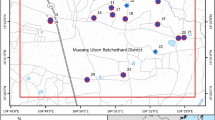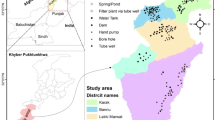Abstract
There have been few investigations of trace elements in the urine and hair of populations exposed to high levels of arsenic (As) in drinking water. Therefore, concentrations of selected metals in urine and hair samples from a population in a study area where arsenism was endemic and a control area were determined. It was found that the median concentrations of barium (Ba), cadmium (Cd), cobalt (Co), chromium (Cr), copper (Cu), manganese (Mn), molybdenum (Mo), nickel (Ni), lead (Pb), zinc (Zn), and As in the urine samples from the population in the study area were 3.87, 0.47, 0.50, 61.84, 26.82, 1.33, 128.45, 7.05, 1.10, 233.75, and 339.63 μg/L, respectively. The corresponding values in the urine samples from a population in the control area were 29.08, 0.19, 0.21, 27.77, 10.32, 4.61, 14.01, 2.19, 3.90, 113.92, and 20.28 μg/L, respectively. In the study area, Ba, Cd, Co, Cr, Cu, Mo, Ni, Pb, and Zn excreted in the urine were likely to be mainly derived from drinking water with high levels of arsenic. The median concentrations of Ba, Cd, Co, Cr, Cu, Mn, Mo, Ni, Pb, Zn, and As in the hair samples from the study area were 4.16, 0.03, 0.09, 1.09, 6.54, 1.97, 0.06, 0.53, 1.64, 144.28, and 1.67 mg/kg, respectively. The corresponding values from the control area were 4.76, 0.03, 0.02, 1.41, 8.31, 1.34, 0.07, 0.39, 0.86, 154.58, and 0.29 mg/kg, respectively. Significant positive correlations were observed between As and Ba, Cd, Co, Cr, Cu, Mo, Ni, Pb, and Zn in the urine in the study area. However, As was not positively associated with these metals in the hair samples. Exposure to high levels of As in drinking water increased the accumulation of Ba and Mn in the hair and the excretion of Cd, Cu, and Mo in the urine in the study area. The population in the study area might experience Cu and Mo deficiencies for an increasing excretion of Cu and Mo.



Similar content being viewed by others
References
Cheng P, Weng S, Chiang C et al (2016) Relationship between arsenic-containing drinking water and skin cancers in the arseniasis endemic areas in Taiwan. J Dermatol 43:181–186
Bulka CM, Jones RM, Turyk M et al (2016) Arsenic in drinking water and prostate cancer in Illinois counties: an ecologic study. Environ Res 148:450–456
Howe CG, Liu X, Hall MN et al (2016) Associations between blood and urine arsenic concentrations and global levels of post-translational histone modifications in Bangladeshi men and women. Environ Health Perspect 124:1234–1240
Fan Y, Jiang Y, Hu P et al (2016) Modification of association between prior lung disease and lung cancer by inhaled arsenic: a prospective occupational-based cohort study in Yunnan, China. J Expo Sci Environ Epidemiol 26:464–470
Christoforidou EP, Riza E, Kales SN et al (2013) Bladder cancer and arsenic through drinking water: a systematic review of epidemiologic evidence. J Environ Sci Health A Toxic Hazard Subst Environ Eng 48:1764–1775
IARC (1987) As and As compounds. IARC monographs on the evaluation of the carcinogenic risk of chemicals to man—overall evaluations of carcinogenicity: an update of IARC monographs 1–42. International Agency for Research on Cancer, Lyon
Wade T, Xia Y, Mumford J et al (2015) Cardiovascular disease and arsenic exposure in Inner Mongolia, China: a case control study. Environ Health 14:35–44
Brauner EV, Nordsborg RB, Andersen ZJ et al (2014) Long-term exposure to low-level arsenic in drinking water and diabetes incidence: a prospective study of the diet, cancer and health cohort. Environ Health Perspect 122:1059–1065
Li X, Li B, Xi S et al (2013) Association of urinary monomethylated arsenic concentration and risk of hypertension: a cross-sectional study from arsenic contaminated areas in northwestern China. Environ Health 12:37–46
Mendez MA, González-Horta C, Sánchez-Ramírez B et al (2016) Chronic exposure to arsenic and markers of cardiometabolic risk: a cross-sectional study in Chihuahua, Mexico. Environ Health Perspect 124:104–111
USEPA (2009) National Primary Drinking Water Regulations. EPA 816-F-09-004, Washington D.C.
WHO (2003) Guidelines for drinking water quality, Third edn. World Health Organization, Geneva
George CM, Sima L, Arias MHJ et al (2014) Arsenic exposure in drinking water: an unrecognized health threat in Peru. Bull World Health Organ 92:565–572
Berglund M, Lindberg AL, Rahman M et al (2011) Gender and age differences in mixed metal exposure and urinary excretion. Environ Res 111:1271–1279
Wang W, Yang L, Hou S et al (2001) Prevention of endemic arsenism with selenium. Curr Sci 81:1215–1218
Yang L, Wang W, Hou S et al (2002) Effects of selenium supplementation on arsenism: an intervention trial in Inner Mongolia. Environ Geochem Health 24:359–374
Denkhaus E, Salnikow K (2002) Nickel essentiality, toxicity, and carcinogenicity. Crit Rev Oncol Hematol 42:35–56
Tsai J, Horng P, Hwang T et al (2004) Determination of urinary trace elements (arsenic, copper, cadmium, manganese, lead, zinc, selenium) in patients with blackfoot disease. Arch Environ Health 59:686–692
Wei BG, Gao JW, Chai YQ et al (2016) Seasonal variations of arsenic in drinking water and urine for exposed population from an endemic arsenism region. Asian J Ecotoxicol 11(4):204–210 (in Chinese)
Chanpiwat P, Himeno S, Sthiannopkao S (2015) Arsenic and other metals’ presence in biomarkers of Cambodians in arsenic contaminated areas. Int J Environ Res Public Health 12:14285–14300
Yamada K (2013) Cobalt: its role in health and disease. Met Ions Life Sci 13:295–320
Tvermoes BE, Paustenbach DJ, Kerger BD et al (2015) Review of cobalt toxicokinetics following oral dosing: implications for health risk assessments and metal-on-metal hip implant patients. Crit Rev Toxicol 45(5):1–21
Qayyum MA, Shah MH (2014) Comparative study of trace elements in blood, scalp hair and nails of prostate cancer patients in relation to healthy donors. Biol Trace Elem Res 162:46–57
Zambelli B, Uversky VN, Ciurli S (2016) Nickel impact on human health: an intrinsic disorder perspective. Biochim Biophys Acta 1864:1714–1731
Zambelli B, Ciurli S (2013) Chapter 10: nickel and human health. Met Ions Life Sci 13:321–357
Vincent JB (2013) Chromium: is it essential, pharmacologically relevant, or toxic? Met Ions Life Sci 13:171–198
Khan FH, Ambreen K, Fatima G et al (2012) Assessment of health risks with reference to oxidative stress and DNA damage in chromium exposed population. Sci Total Environ 430:68–74
Mikoczy Z, Hagmar L (2005) Cancer incidence in the Swedish leather tanning industry: updated findings 1958–99. Occup Environ Med 62:461–464
Sahar U, Nandi R, Saha B (2011) Sources and toxicity of hexavalent chromium. J Coord Chem 64:1782–1806
ATSDR (Agency of Toxic Substances and Disease Registry) (2000) Toxicological profile for manganese. U.S. Department of Health and Human Services Public Health Service, Atlanta, Georgia
Avila DS, Puntel RL, Aschner M (2013) Manganese in health and disease. Met Ions Life Sci 13:199–227
Kravchenko J, Darrah TH, Miller RK et al (2014) A review of the health impacts of barium from natural and anthropogenic exposure. Environ Geochem Health 36:797–814
IARC (International Agency for Research on Cancer) (1993) Cadmium. IARC Monogr Eval Carcinog Risk Hum 58:119–238
Adams SV, Shafer MM, Bonner MR et al (2016) Urinary cadmium and risk of invasive breast cancer in the women’s health initiative. Am J Epidemiol 183(9):815–823
Bost M, Houdart S, Oberli M et al (2016) Dietary copper and human health: current evidence and unresolved issues. J Trace Elem Med Bio 35:107–115
Zatta P, Drago D, Zambenedetti P et al (2008) Accumulation of copper and other metal ions, and metallothionein I/II expression in the bovine brain as a function of aging. J Chem Neuroanat 36(1):1–5
Mahabir S, Forman M, Dong YQ et al (2010) Mineral intake and lung cancer risk in the NIH-American Association of retired persons diet and health study. Cancer Epidemiol Biomark Prev 19(8):1976–1983
Schwarz G, Belaidi AA (2013) Molybdenum in human health and disease. Met Ions Life Sci 13:415–450
Acknowledgements
This work was financially supported by the State Key Program of National Natural Science of China (grant no. 41230749) and the National Natural Science Foundation of China (grant no. 41601559).
Author information
Authors and Affiliations
Corresponding authors
Rights and permissions
About this article
Cite this article
Wei, B., Yu, J., Wang, J. et al. Trace Metals in the Urine and Hair of a Population in an Endemic Arsenism Area. Biol Trace Elem Res 182, 209–216 (2018). https://doi.org/10.1007/s12011-017-1108-x
Received:
Accepted:
Published:
Issue Date:
DOI: https://doi.org/10.1007/s12011-017-1108-x




